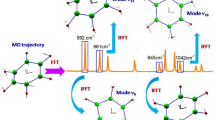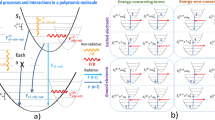Abstract
IN a previous communication1 we indicated how, in the example of the 1B2u state of C6H6 and C6D6, the product theorem and computations of force constants could be used to calculate or verify vibrational frequencies in electronically excited molecules. The discussion was almost entirely confined to the out-of-plane vibrations of both molecules, as insufficient experimental data were then available to permit calculations of the product ratios or force constants of the in-plane vibrations. It has now, however, been found possible to apply these methods to the in-plane vibrations, thus completing the first determination of a force system of an excited polyatomic molecule.
This is a preview of subscription content, access via your institution
Access options
Subscribe to this journal
Receive 51 print issues and online access
$199.00 per year
only $3.90 per issue
Buy this article
- Purchase on SpringerLink
- Instant access to full article PDF
Prices may be subject to local taxes which are calculated during checkout
Similar content being viewed by others
References
Nature, 157, 46 (1946).
J. Chem. Phys., 7, 207 (1939).
J. Chem. Phys., 8, 705 (1940).
J. Chem. Soc., 256 (1946).
Phys. Rev., 45, 712 (1934).
Z. Phys. Chem., 30, 307 (1935).
Author information
Authors and Affiliations
Rights and permissions
About this article
Cite this article
INGOLD, C., GARFORTH, F. Polyatomic Electronic Spectra: Further Analysis of the Vibrations of the 1B2u State of Benzene. Nature 158, 163–164 (1946). https://doi.org/10.1038/158163b0
Issue date:
DOI: https://doi.org/10.1038/158163b0



